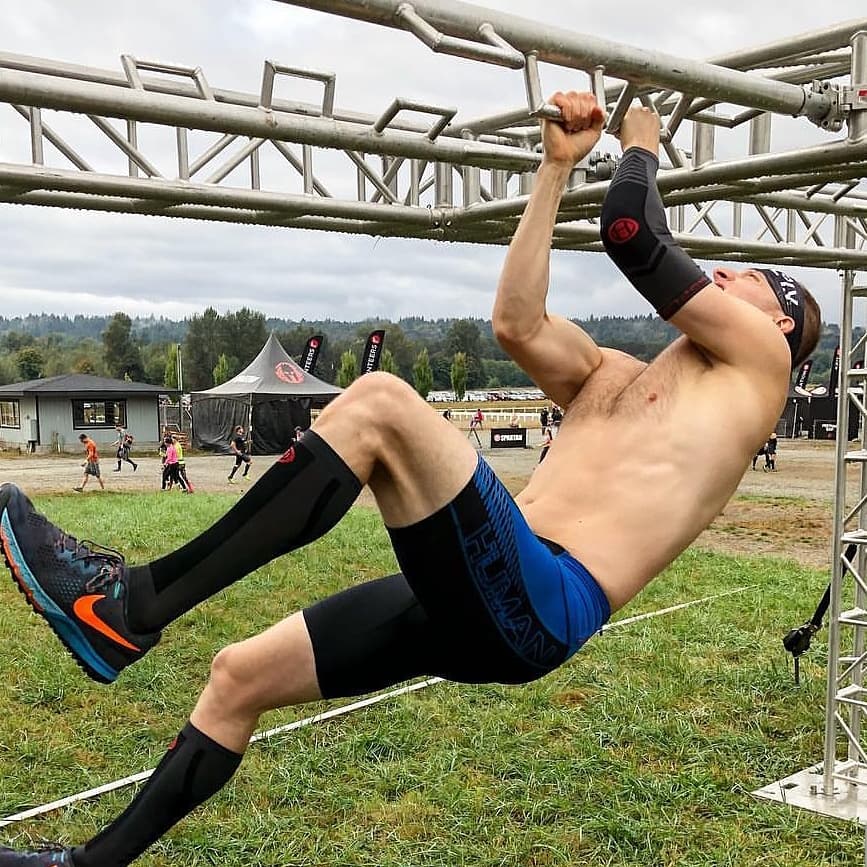Does Compression Work?
You've probably seen people at races, at the gym, hiking, or just playing ball wearing compression socks or sleeves.
You may have thought to yourself, “Do those really work?” or “I wonder if those would help my shin splints or calf cramps?” or "what do they do?"
Compression can benefit anyone, athletes and couch potatoes alike. With the growth of high intensity athletic endeavors like Obstacle Racing, CrossFit and Rucking I get a lot of questions about compression. Most commonly, people want to know how it works, if they need it, and if it can benefit them. Let's take a few minutes to explain the reasons for using compression, how it can benefit you.

Before we discuss the benefits of compression, it’s important to have a basic understanding of how blood flows through the body.
The heart pumps oxygen containing blood to our extremities and working muscles though arteries. This is relatively high pressure and generally helped by gravity.
Once the cells use the oxygen and other nutrients from the blood, the then deoxygenated blood, along with lactic acid and other waste products enter the veins to travel back to the heart.
The blood in veins is traveling at lower pressure, against gravity, shock and momentum.
Once the blood gets back to the heart, it’s oxygenated from the lungs and the process is repeated.

Maintaining efficient blood flow to and from your muscles is important for performance. The more oxygen the cells have, the better they will function.
During exercise, the body produces lactic acid, lactate, and other waste products. If these waste products are not removed from the muscles, they cause fatigue, soreness, and decreased strength of contractions.
Shock and vibration from impact and repetitive action also contributes to fatigue. Think about how much shock and vibration is going through your leg muscles with each stride as you run. 3-5 times your body weight impacts each leg, every stride. Over time, the shock and vibrations of the muscles add up and cause fatigue.
Gravity, momentum, and shock can lead to swelling, especially in the lower extremities, that progressively degrades circulation, causing swelling, increasing fatigue, and reducing strength of contraction.
You can also have swelling and increased risk of forming blood clots with extended sitting. Constriction of blood flow around the knees and hips while sitting leads to swelling and stagnation of venous blood with all its waste products in the legs and feet.

Now that we know what the blood and muscles are doing while running, working out or even just sitting around, let’s talk about what compression socks and sleeves do to help.
What do Compression Socks and Sleeves do anyway?
Many compression socks and sleeves provide graduated compression, meaning the compression is higher (tighter) at the foot and ankle and lower (looser) as it moves up the calf and lower leg. This type of compression helps to fight the effects of gravity and tissue pressure assisting the body in venous return (deoxygenated blood flowing back up to the heart). This helps remove waste products from your muscles and joints.
More Efficient Blood Flow
Recent studies show that with consistent compression, the walls of the arteries will dilate, increasing the blood flow through them. Arterial blood flow has been shown to increase up to 40% during activity and 30% during recovery. This means more oxygen and nutrients flowing through the body! On the other hand, the walls of the veins will constrict under compression, which helps to increase the velocity of blood flow through them. Increased velocity of blood flow through veins means that deoxygenated blood and waste products are removed faster, which will help to increase the rate of recovery and decrease muscle soreness!
Stabilizes Muscles and Connective Tissues
Compression also helps stabilize muscle and connective tissue reducing muscular shock and vibration, resulting in decreased fatigue. Compression aids in maintaining the alignment of muscles and tendons in action reducing flare ups of tendinitis and other inflammation.

To sum up the benefits of compression; enhanced performance through increased blood flow, decreased muscle soreness, less fatigue, and faster recovery. All good things! Compression helps relieve tendonitis and inflammation to help you stay active and continue working.
- Improved Blood Flow
- Decreased Muscle Soreness
- Less Fatigue
- Faster Recovery
- Relief from Tendonitis
So are compression socks or sleeves good for shin splints, calf cramps / strains, and Achilles tendonitis?
The answer is yes, combined with treatment modalities like NSAIDs, ice and stretching, compression can help speed up your recovery and healing. All injuries should be assessed so that the real cause can be addressed. Wearing compression can help to make your injury feel better as you are recovering, help get you through that last long run before your marathon, or possibly prevent a new injury from coming on. Proper rest, stretching / strengthening, footwear, and progression of training should all be considered when dealing with a lower leg injury.
Arm sleeves can help relieve pain and improve recovery from tennis elbow, climbers elbow, and forearm tendonitis.
What if you’re not injured, can you still benefit from compression? Absolutely! Compression wear will help improve your performance and decrease the rate of fatigue of your muscles. It will also help you to recover faster, meaning that you will be ready for your next workout, so you can train harder. Compression socks and sleeves can also help you avoid these injuries. The best treatment is prevention.
Should I wear socks or sleeves? The answer to this question depends on a few things. If your injury involves your arch, ankle, or lower Achilles tendon, you are going to want to wear a sock to cover the injured area. If your injury is up higher, a sleeve should be fine. Another factor to take into consideration is what type of sock you like to wear. If you have a favorite pair of running socks that you can’t run without, you will probably like the sleeve better since you can wear your favorite socks with it.
Don’t forget about wearing compression while you travel to and from your race or on a business trip. Sitting in a plane or car for an extended period of time can wreak havoc on the blood flow in our legs. Let compression assist your veins in getting that blood out of your legs and back to your heart!
Whether you are trying to ease the symptoms of shin splints or calf pain, or looking to get an edge on the competition during competition and through quicker recovery, compression can help!






